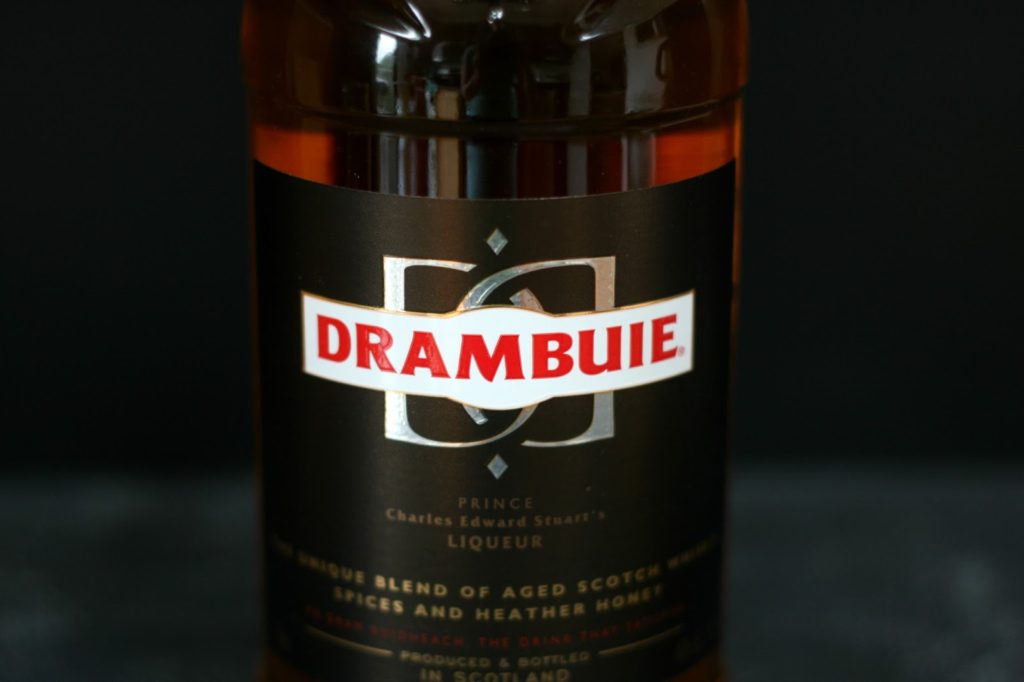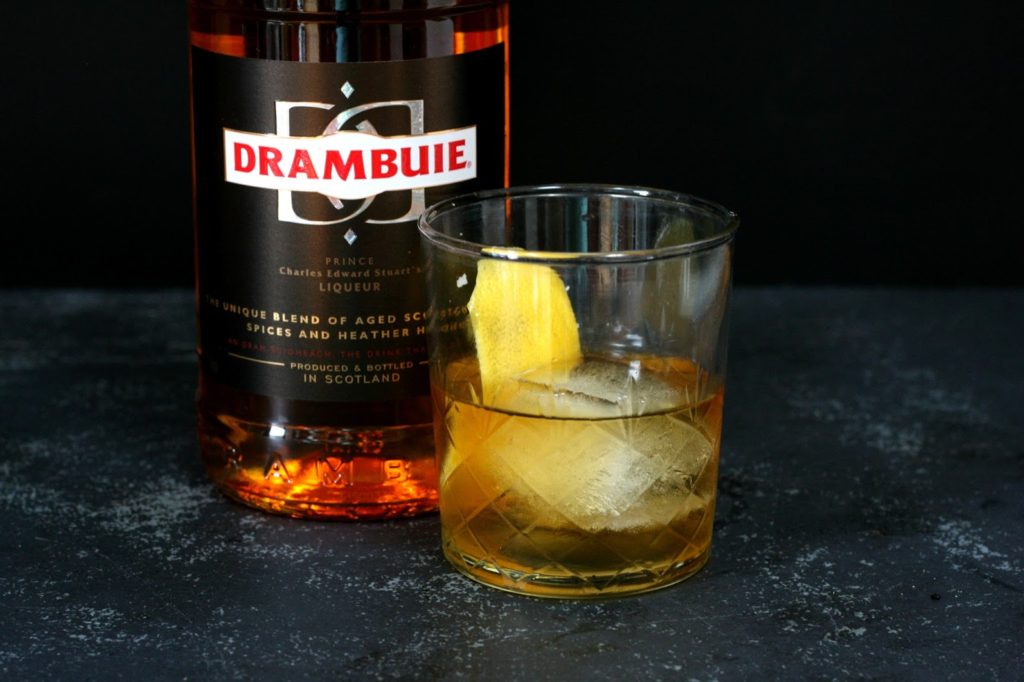I’ve got another new ingredient to introduce today: Drambuie. Best known for its use in the Rusty Nail, this Scottish liqueur traces its roots back to English royalty. It doesn’t seem to show up in that many cocktails, but it’s got a fantastic flavor that I’d like to play around with more.
Drambuie is a Scotch-based liqueur flavored with spices, herbs, and honey. The exact recipe is a well-kept secret, and has been for a long time. The main flavors I get when I taste it are anise and honey, with hints of spices and citrus. It’s thick and a bit syrupy on its own. It would make a nice after-dinner drink.
Drambuie claims that the recipe was first developed by the Royal Apothecary for Bonnie Prince Charlie in the 18th century. If you’re fuzzy on your British royals like I am, let me fill you in. You don’t need to know this to enjoy your Drambuie, but I think it makes it a lot more fun.
Bonnie Prince Charlie was a Stuart, a member of the royal house of Scotland. His grandfather James II was King of England, but he was exiled in the Glorious Revolution for being a Catholic. James II’s son, also named James, tried to regain the throne and failed, so it fell to his grandson Charles (aka Bonnie Prince Charlie), who was named regent in 1743 at the age of 23.
 |
| Charles Edward Stuart, aka “Bonnie Prince Charlie,” in 1745 |
With the throne of England, the legitimacy of the Catholic faith, and his family’s honor hanging in the balance, one can imagine that Charlie might have needed a stiff drink every now and then. Drambuie says he would have a few drops of a concoction developed by his apothecary every day “for strength and vitality.” Unfortunately, it didn’t help him win the Battle of Culloden, and Charlie lost his chance to re-take the throne. He ended up on the run in Scotland, where the Highlanders protected and helped him.
Legend has it that one of these Highlanders was John MacKinnon, Chief of Clan MacKinnon, who helped Charles escape from the Isle of Skye. To thank him, Bonnie Prince Charles gave him the recipe for his liqueur. The clan passed it down for generations, until a hotel proprietor named John Ross began serving it to his patrons on the Isle of Skye in 1873. His customers loved it, calling it “an dram buidheach” in Gaelic, meaning “the drink that satisfies.” It was popular enough that Malcom MacKinnon began producing it to sell in 1909, using the phrase as inspiration for its name, Drambuie.
How much of this is actually true? Probably not much. Attributing the recipe to Bonnie Prince Charles is a great marketing scheme. But you never know! After all, they’re confident enough to put “Prince Charles Edward Stuart’s Liqueur” right there on the label.
Drambuie
Price: $35
Alcohol Content: 40%
Popular Cocktails: Rusty Nail, Bonnie Prince Charles, Bobby Burns
When it comes to cocktails, Drambuie is basically synonymous with the Rusty Nail. A mixture of Scotch and Drambuie with a lemon twist, it’s a simple but delicious recipe. It’s also quite a strong cocktail. A knock-you-on-your-ass, I-don’t-even-remember-doing-that sort of cocktail. It’s something about the Drambuie that just makes it go down a little too easy. My parents introduced me to it a couple of Christmases ago, and they told me their notorious Rusty Nail story: a friend of theirs had a few too many and stumbled home drunk without his house keys. He ended up kicking down his own front door in the middle of the night. The next morning his toddler asked “Is Daddy a cowboy?”
By the same token, I have a couple of friends who say they’d love to get into Scotch but they just don’t like it by itself. The sweet, herbal Drambuie makes the Rusty Nail a nice gateway cocktail for would-be Scotch drinkers.
A Rusty Nail usually calls for a blended Scotch. My current favorite is Monkey Shoulder. You’ll also want to experiment with the ratio of Scotch to Drambuie. Drambuie is quite sweet, so I like the 4:1 ratio here. But it can go as high as 1:1. You can also add a little squeeze of lemon juice if you want a bit more citrus.
History: According to David Wondrich, the earliest mention of a Scotch and Drambuie cocktail is in 1937, when the B.I.F. was introduced by F. Benniman for the British Industries Fair. A 3:1 ratio served up with a dash of Angostura bitters, it wasn’t quite the same as a Rusty Nail. After that, Drambuie + Scotch became a somewhat common cocktail formula, but it existed under many names, from the self explanatory D & S to the more obscure Knucklehead and Mig-21. At some point, somebody started calling it a Rusty Nail. Drambuie embraced the cocktail, and their chairwoman Gina MacKinnon (yep, still a MacKinnon) mentioned the Rusty Nail by name in the New York Times in 1963, putting to rest any other contenders. At this point, it was a 1:1 formula, meant to be built in a glass. Easy and unfussy, it became a very popular cocktail to make at home during this time. It was famously enjoyed by the Rat Pack.
Something about the Rusty Nail still evokes the image of a mirrored bar cart sitting in a den full of midcentury furniture, velvet sofas, and wood-paneled walls. It’s retro, almost tacky. It’s what your dad drinks. In the premier of the Breaking Bad spinoff Better Call Saul, Saul Goodman makes himself a Rusty Nail at home, prompting Gothamist to write the article “Of Course Saul Goodman Drinks Rusty Nails.” If you’re at all familiar with the character, it totally fits. Maybe the Rusty Nail was just popular at an awkward time for cocktails – too recently to be lumped in with romantic, Prohibition-era recipes and too long ago to benefit from the current mixology renaissance. But I’d argue that it’s still worthy of some attention. I hope we see a Rusty Nail comeback in the near future.
Rusty Nail
2 oz. Scotch
1/2 oz. Drambuie
Combine Scotch and Drambuie in a rocks glass with one or two large ice cubes and stir gently. Garnish with a lemon twist.









It's fun to play bitter amari off the sweentess in Drambuie. Kind of a yin/yang thing going on.